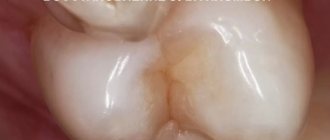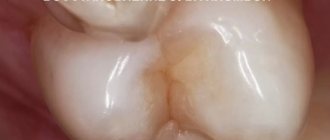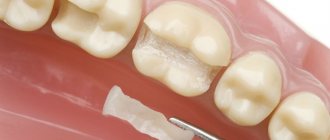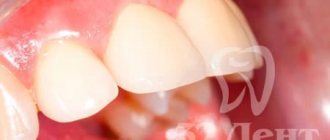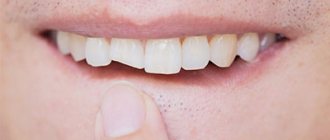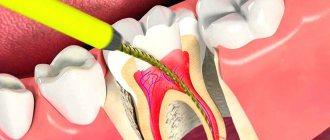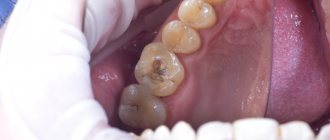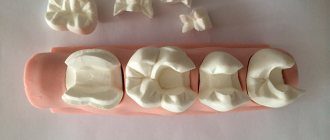Ceramic inlays for teeth are non-removable microprostheses that are used to restore damaged dental tissue. Typically, this method is taken as a basis in cases where it is not possible to cope with a given dental problem using therapeutic techniques, that is, filling. At the same time, using a ceramic inlay will give the tooth its natural shape and protect it from damage. In this case, the result obtained will be very aesthetic and long-lasting.
If you are faced with severe tooth decay and are afraid of losing it, do not hesitate, contact the Dental Studio clinic in Moscow. Our specialists have technologies that allow us to save a badly damaged tooth without resorting to fillings or installing crowns.
How does an inlay differ from a filling?
The filling is made of a plastic material that hardens and takes the desired shape. It is made and installed right in the dentist's office in one appointment. However, a filling will not help when the tooth is severely damaged. In this case, you will need a ceramic inlay. It is made in the laboratory using an individual impression. It not only closes the resulting cavity, but also exactly repeats the shape of the destroyed area of the crown.
Advantages over fillings:
- Higher efficiency
. It is possible to restore a severely damaged tooth. A filling is suitable only if the cavity occupies less than a quarter of the crown, and an inlay can restore from 25 to 60%; - Naturalness
. The inlay imitates the anatomical shape of the chewing surface. It is almost invisible, while the filling can be seen; - Higher strength
. Microprostheses do not develop cracks. A filling of this size would quickly crumble, so it is not suitable for restoring extensive damage; - Durability
. The tab will last 5–7 years. At the same time, it will remain unchanged and will not lose its original characteristics; - Ensuring the prevention of secondary caries
. Sometimes the filling can become infected again. The insert fits very tightly and does not shrink over time, so this risk is eliminated; - Color fastness
. The fillings have a porous structure, so they are easily stained by tea, coffee, and tobacco. Ceramics are not subject to color changes.
Flaws:
- They cost more;
- They take longer to produce. The filling can be placed in one visit to the dentist. And to install the tab, you will need 2 visits with a break for the manufacture of a microprosthesis in the laboratory.
Ultraneers
Ultraneers
- popular ceramic dental plates with a thickness of 0.6 mm: they are thicker than lumineers, but thinner than classic veneers. They are distinguished by good aesthetic characteristics, comparable to those of lumineers, strength, fast production times, and a reasonable price. This is a good alternative to lumineers (30-35% cheaper), which is installed using a minimally invasive method.
Indications
The main use case is the treatment of caries. A ceramic inlay for a tooth is needed if its crown is destroyed by 25–60%. If the cavity occupies less than a quarter of the surface, then you can get by with a filling, but if more than 60%, then a crown is needed. Other indications for installation:
- Destruction of non-carious origin;
- The need to install a bridge prosthesis (microprostheses are placed on abutment teeth to increase their strength);
- Increased abrasion of enamel.
Veneers
Veneers are ceramic plates used to restore the front row of teeth. They are installed on both the upper and lower teeth.
Veneers can eliminate many defects:
- crooked teeth;
- enlarged interdental gaps;
- chips and cracks;
- pigmentation or darkening of the enamel.
To fix veneers, it is necessary to grind a thin layer of enamel and secure them with special cement, which will securely hold the structure on the teeth. The service life of veneers is up to 15 years
. They do not require special care.
Contraindications
This type of microprosthesis cannot be installed in the following cases:
- bruxism (grinding teeth in sleep);
- steep slopes of hillocks;
- rapidly progressing caries;
- deep cavity extending into dentin;
- inability to ensure complete dryness of the field.
A relative contraindication is poor oral hygiene. In what cases is it not advisable to use:
- A cavity less than 1.5 mm deep (you can get by with a filling);
- The damage has affected the cervical area of the tooth (the inlay will no longer help);
- The tooth is more than 60% destroyed (a crown is required);
- Milk tooth. It makes no sense to restore it using an inlay, since the life of the tooth is less than the durability of the microprosthesis. In addition, a vlkadka costs much more than a filling. Spending so much money to restore a tooth that will soon fall out is not advisable.
Are there any complications?
The most common complication is the appearance of caries in the deep tissues under the prosthesis. Detachment of the “onlay” from the dental walls, chipping of ceramics or composite (or even the walls around the denture with the development of cervical caries, for example), can also occur. Another possible complication is injury to the antagonist tooth (chip or periodontitis). Complications occur if the following mistakes are made:
- preliminary diagnosis was incomplete or carious tissue was poorly removed,
- the patient, while wearing a temporary filling, did not follow the recommendations of the orthopedist and chewed intensively on the prosthetic side,
- violation of technology when taking impressions, manufacturing, fitting and installation.
Types of tabs
Depending on the material of manufacture, they come in the following types:
- metal-ceramic
- the most budget-friendly; - ceramic
– the most aesthetic; - made of zirconium dioxide
- the most durable.
These microprostheses are also classified depending on their position in the tooth. According to this criterion, the following varieties are distinguished:
- Inlay
– the hole in the tooth is box-shaped, the inlay is installed inside it; - Onlay
– the overlay has an external side; - Overlay
– only one wall is preserved, the overlay replaces almost the entire crown; - Pinlay
– the inlay has additional cavities or pin inclusions for better fixation.
The type of inlay based on its position in the tooth is selected by the dentist after an initial consultation.
Quality assessment parameters
High-quality microprostheses must be produced with the highest precision and according to the individual parameters of a particular patient. Therefore, a good prosthesis can be made in 1-3 weeks, which includes not only the production itself, but also modeling, creating a blank, and trying it on to evaluate all the characteristics.
Complex on 4 OSSTEM implants with delayed loading - from RUB 170,000.
Complex implantation Osstem (South Korea) with delayed loading after 4-6 months.
Guarantee for the doctor’s work - unlimited Call now or order a call
Opening hours: 24 hours a day - seven days a week
Before choosing the type and material of a microprosthesis, the dentist must conduct a diagnosis. It also includes an X-ray examination to determine possible pathologies (caries, pulpitis, periodontitis, etc.). X-rays are also taken after prosthetics to assess the tightness of the fit to the walls and the absence of air cavities. By the way, during regular medical examinations the dentist can also take x-rays of the restoration - to identify the nuances and pathologies mentioned earlier.
The process of manufacturing and installing inlays on a tooth
Dental prosthetics is performed in several stages:
- Initial consultation
. The doctor assesses the extent of destruction and draws up a recovery plan; - Hygienic teeth cleaning
if necessary; - Selection of the required shade
to match the enamel color; - Removal of tissues affected by caries
, if the destruction was caused by this disease; - Taking an individual impression
, according to which a microprosthesis will be made; - Closing the cavity with temporary material
for the waiting period; - Making an inlay
based on an individual impression in a dental laboratory; - Installation
of the inlay and its fixation using special dental cement.
Thus, a tooth can be restored in 2 visits to the clinic. The first visit is a consultation, treatment of caries and taking an impression, the second is the actual installation.
Tooth restoration with a crown using metal-ceramics
An inexpensive solution is a one-piece tooth crown. It is durable and justified for molar prosthetics. The durable frame is covered with layers of ceramics. This design is aesthetic and convenient.
Tooth restoration with a metal-ceramic crown is a budget-friendly and reliable way to maintain the health of your teeth. The cost of a crown is 17,900 rubles per tooth. An impression is made that follows the contours of the natural crown, recording the characteristics of the bite, and a frame is created according to the obtained parameters. Each applied layer of porcelain coating is baked under high temperature.
If there is no healthy root, the tooth has long been removed, there are problems with the structure of soft and bone tissues, then the only way to return to your normal lifestyle and maintain health is implantation. Today there are methods for restoring a tooth crown, completely replacing a lost unit - in my clinic the cost of metal-free options is from 27,900 rubles
for a destroyed restored tooth (and
from 34,900 rubles
for a crown for an implant).
I, Dr. Samsakov, will produce ceramic tooth modules of any complexity, post-core and other types of inlays, “crown plus tooth root” modules using CEREC technology - cost from 27,900 rubles. per tooth The process will take about 1.5 hours.
Pros of ceramic inlays
A ceramic tooth inlay has many advantages:
- High strength
. An inlay, unlike a filling, significantly strengthens the tooth. Therefore, it is the preferred option if the tooth in which it is installed will be used as a support for a bridge; - Good aesthetic properties
. Ceramics are translucent, so they successfully imitate the natural color of the tooth. It also exactly follows the normal shape of his crown; - The ability to fully restore the chewing surface
. The inlay completely follows the anatomical shape of the tooth. This provides convenience when eating; - Hygiene
. Glaze is applied to the tab as a finishing layer. It creates a glossy surface on which plaque does not accumulate; - Resistance to external factors
. Ceramics does not darken over time, does not change color due to smoking or drinking coloring drinks; - Durability
. A ceramic inlay will last longer than a filling – 5–7 years. There are also more durable inlays, for example, made of zirconium dioxide, but ceramic ones are more aesthetically pleasing compared to them; - No risk of secondary caries
. Inlays, unlike fillings, do not shrink and adhere tightly to the tissue. This eliminates the possibility of cracks and the development of secondary carious lesions; - Easy replacement
. When installing a new inlay after its service life has expired, there is no need to grind the tooth again. Caries does not develop under a microprosthesis of this type, so there is no need to remove the affected tissue. - Bioinertness
. Ceramics does not absorb or accumulate any odors. There is no plaque deposited on it; - Hypoallergenic
. Microprostheses made of pure ceramics do not cause any immune reactions; - No need for special care
. Regular hygiene rules are sufficient.
Composite overlays
Composite dental onlays are an excellent alternative to expensive veneers and lumineers. These onlays are installed immediately in the mouth on the first visit.
Microprostheses made of composite materials perform an aesthetic function: they make teeth whiter and smoother, and eliminate minor defects. Service life - from 2 to 5 years
. Over time they may darken. The composite material is quite fragile, so you should avoid eating solid foods, which can damage the prosthesis.
